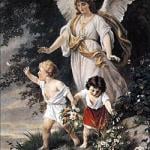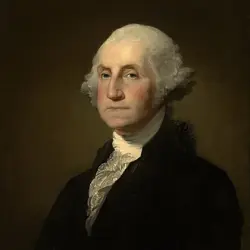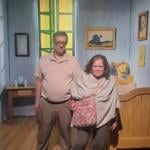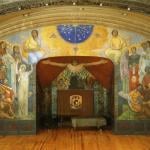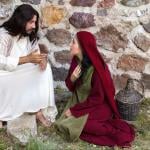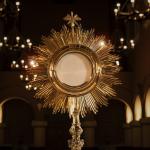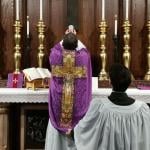Time is a funny thing. When looking at past events a year can seem like worlds away, yet when you really think about it a year is really not that long ago. When you look at time through the lens of eternity…
But do not forget this one thing, dear friends:
With the Lord a day is like a thousand years, and a thousand years are like a day.2 Peter 3:8 New International Version
Was it really all that long ago that the Franciscans and Dominicans began their religious orders?
Was it really all that long ago that an invention made books accessible to the masses?
Was it all that long ago that Columbus discovered the new world?
Was it all that long ago that the Mona Lisa was first painted for the world to look at?
Was it all that long ago that Handel composed the tune that had us singing ‘For unto us a child is born’?
Was it all that long ago that Gulliver first stepped into Lilliput?
Was it all that long ago that the first piano was built and the first baseball game played?
Let’s take a look back at the centuries leading up to our present starting in the
2nd Millenium
11th Century
1000 years ago
Religious Disputes and Classic Lit and Learning Begins
1025
The noblewoman, poet, and lady-in-waiting Murasaki Shikibu (c. 973 – c. 1014 or 1025) probably dies. Four years earlier in 1021 she completed The Tale of Genji (源氏物語, Genji Monogatari; Japanese pronunciation: [ɡeɲ.dʑi mo.no.ɡaꜜ.ta.ɾʲi]) which is a classic work of Japanese literature written around the peak of the Heian period, in the early 11th century. It is often considered to be history’s first novel, as well as the first by a woman to have won global recognition. In Japan, The Tale of Genji has a stature similar to that of Shakespeare in the UK.

At around this time the epic poem Beowulf was written between 975 and 1025
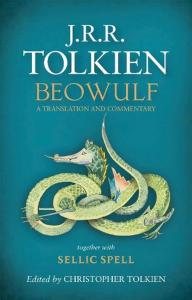
971 years ago
July 16, 1054
East-West Schism: Humbert of Silva Candida, representative of the newly deceased Leo IX, breaks the relations between Western and Eastern Churches, through the act of placing an invalidly-issued Papal Bull of excommunication during the celebration of the Divine Liturgy.
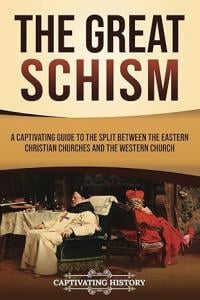
937 years ago
1088
The University of Bologna, a public research university in Bologna, Italy is established. It is the oldest university in continuous operation in the world, and the first degree-awarding institution of higher learning.
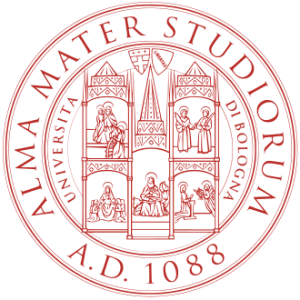
929 Years Ago
1096–1099
The First Crusade was the first of a series of religious wars, or Crusades, which were initiated, supported and at times directed by the Latin Church in the Middle Ages. Their aim was to return the Holy Land—which had been conquered by the Rashidun Caliphate in the 7th century—to Christian rule. By the 11th century, although Jerusalem had then been ruled by Muslims for hundreds of years, the practices of the Seljuk rulers in the region began to threaten local Christian populations, pilgrimages from the West and the Byzantine Empire itself. The earliest impetus for the First Crusade came in 1095 when Byzantine emperor Alexios I Komnenos sent ambassadors to the Council of Piacenza to request military support in the empire’s conflict with the Seljuk-led Turks. This was followed later in the year by the Council of Clermont, at which Pope Urban II gave a speech supporting the Byzantine request and urging faithful Christians to undertake an armed pilgrimage to Jerusalem.
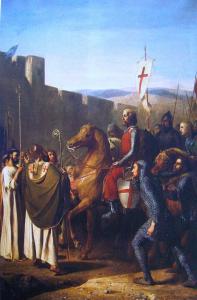
12th Century
925 Years Ago
1100
Great Architecture and Founding’s Occur
MEANWHILE IN AFRICA
A collective of Tuareg trading clans decide to permanently settle the city of Timbuktu (modern Mali,Africa) north of Djenné along the Niger River. Timbuktu will later achieve fame as a center of Islamic learning. The Sankore, Djinguereber and Sidi Yahya mosques are among Timbuktu’s most famous religious and scholarly institutions (approximate date).
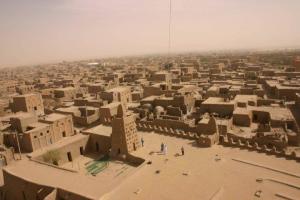
921 Years Ago
1104
The Venice Arsenal of Venice, Italy, is founded. It employed some 16,000 people for the mass production of sailing ships in large assembly lines, hundreds of years before the Industrial Revolution.
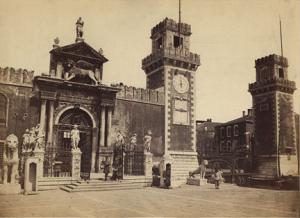
910 Years Ago
1115
Clairvaux Abbey is founded by St. Bernard, French abbot and a major leader in the reform of Benedictine monasticism, in France.
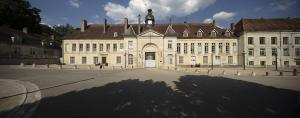
892 Years Ago
1133
The first convent on Iceland, the Þingeyraklaustur, is inaugurated at a monastery of the Order of Saint Benedict (located in Þingeyrar).
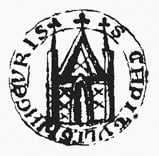
860 Years Ago
1165
The Liuhe Pagoda of Hangzhou, China, is reconstructed fully after being destroyed in 1121.

About 890 Years Ago
Somewhere between 1135–1154
The legend of the green children of Woolpit concerns two children of unusual skin colour speaking an apparently unknown language who reportedly appeared in the village of Woolpit in Suffolk, England, sometime in the 12th century, perhaps during the reign of King Stephen.
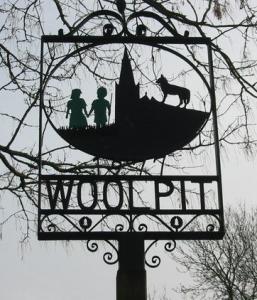
840 Years Ago
1185?
- Tradition indicates that the Carmelite order was founded this year but that is based on the story of a pilgrim in the Holy Land, the interpretation of which remains questionable.
- 1185: First record of windmills.
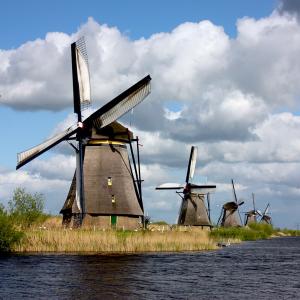
834 Years Ago
1191
Zen Buddhism was introduced to Japan in 1191 by a Japanese Buddhist priest named Eisai (May 27, 1141 – 1 August 1, 1215). This school of Zen Buddhism was one of the first to arrive in Japan and quickly became popular among the samurai class. The samurai embraced Zen Buddhism for its emphasis on discipline, attention, and detachment, which were highly valued by the samurai.
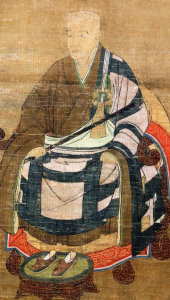
13th Century
825 Years Ago
1200
The Catholic Faith Gives Us Long Lasting Religious Orders and Theology
MEANWHILE IN YET UNDISCOVERED NORTH AMERICA
Construction begins on the Grand Village of the Natchez near Natchez, Mississippi. This ceremonial center for the Natchez people is occupied and built until the early 17th century.
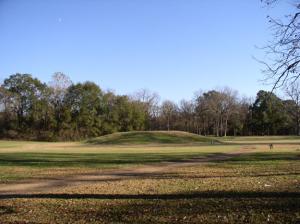
819 Years Ago
1206
Genghis Khan is declared Great Khan of the Mongols.
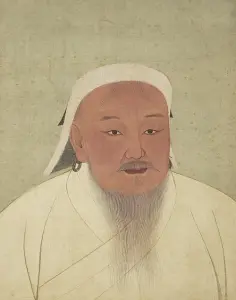
1209
Francis of Assisi founds the Franciscan Order.
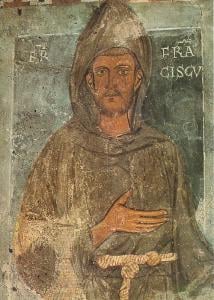
810 Years Ago
1215
- The Order of Preachers (Dominicans) was founded by St. Dominic de Guzman.
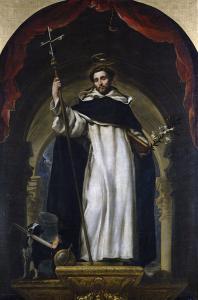
The affirmation of the doctrine on the real presence of Christ in the Eucharist was expressed, using the word “transubstantiate”, by the Fourth Council of the Lateran
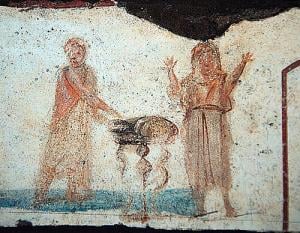
799 Years Ago
January 30, 1226
The rule of St. Albert for the Carmelites was finally approved by a pope in the bull Ut vivendi normam of Honorius III. Three years later in 1229 Pope Gregory IX confirmed this rule again and gave it the status of Regula bullata.
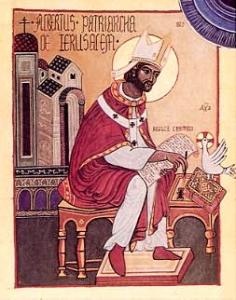
769 Years Ago
1256
The Hermits of St. Augustine (Augustinians) is founded when different communities that followed the Rule of St. Augustine were united.
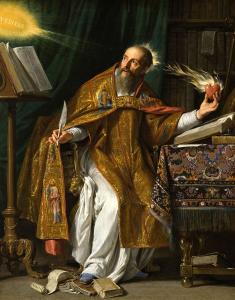
751 Years Ago
1274
- Dr., St. Thomas Aquinas (c. 1225 – March 7, 1274) left his master work the Summa Theologica incomplete at the time of his death.
- May 7 – Second Council of Lyon: Pope Gregory X convenes a council at Lyon, after Byzantine Emperor Michael VIII Palaiologos gives assurances that the Orthodox Church is prepared to reunite with Rome. The council agrees to a settlement between the Catholic Church and the Orthodox Church over several key issues – Orthodox acceptance of papal primacy and the acceptance of the Nicene Creed with the Filioque clause. Gregory approves a tithe to support efforts to liberate the Holy Land from Muslims, and reaches apparent resolution of the schism, which ultimately proves unsuccessful. All but four mendicant orders of friars are suppressed. Catholic teaching on Purgatory is defined for the first time
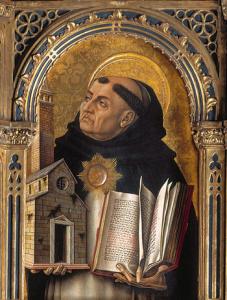
14th Century
725 Years Ago
1300
The World Begins to Expand and Gets Creative
The Travels of Marco Polo (also known as Book of the Marvels of the World and Il Milione, c. 1300), is published. It is a book that described the then-mysterious culture and inner workings of the Eastern world, including the wealth and great size of the Mongol Empire and China under the Yuan dynasty, giving Europeans their first comprehensive look into China, Persia, India, Japan, and other Asian societies.
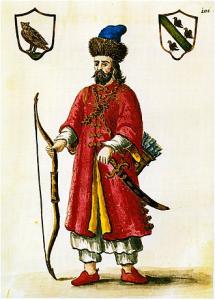
720 Years Ago
1305
Sir William Wallace AKA Braveheart (c. 1270 – August 23, 1305) was a Scottish knight who became one of the main leaders during the First War of Scottish Independence. In August 1305, Wallace was captured in Robroyston, near Glasgow, and handed over to King Edward I of England, who had him hanged, drawn and quartered for high treason and crimes against English civilians.
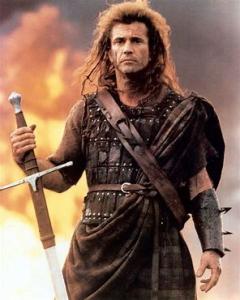
Lamentation (The Mourning of Christ) is a fresco painted c.1305 by the Italian artist Giotto as part of his cycle of the Life of Christ on the interior walls of the Scrovegni Chapel in Padua, Italy.
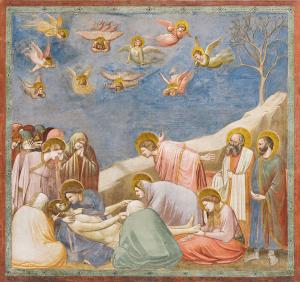
705 Years Ago
1320
The Divine Comedy begun 1308 is completed by Dante Alighieri (1265 – September 14, 1321).
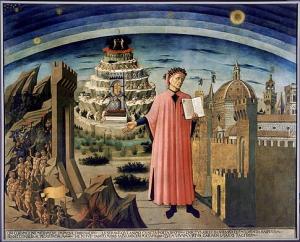
691 Years Ago
1334
Pope # 197 Non-Saint Benedict XII (December 20, 1334 – April 25, 1342 – 7 years, 126 days) institutes the Papal Cappella, which would eventually become the Capella Sistina or Sistine Chapel.
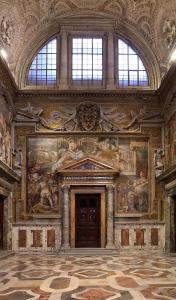
660 Years Ago
Before 1365
Messe de Nostre Dame (Mass of Our Lady) is a polyphonic mass composed by French poet and composer Guillaume de Machaut (c. 1300–1377). Widely regarded as one of the masterpieces of medieval music and of all religious music, it is historically notable as the earliest complete setting of the Ordinary of the Mass attributable to a single composer (in contrast to earlier compilations such as the Tournai Mass).
652 Years Ago
1373
Merton College Library is built in Oxford, England. It is one of the earliest libraries in England and one of the oldest academic library in the world still in continuous daily use.
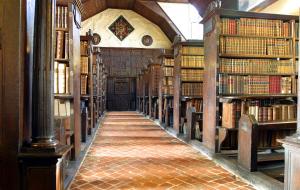
635 Years Ago
1390
The monastery at Durham appoints John Stele to teach the Benedictine monks and eight secular boys to play the organs and to sing “triple song” (possibly faburden)
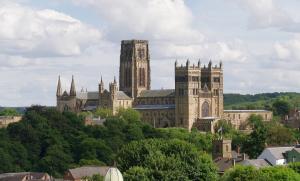
631 Years Ago
December 6,1394
The astronomical clock of St. Nicholas Church in Stralsund is finished and signed by Nikolaus Lilienfeld. It was probably damaged in the 16th century, and has not worked since then. It is the only clock of its kind to have been preserved almost entirely in its original condition. The clockwork and the indications have not been restored.
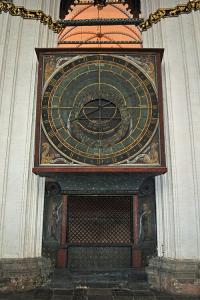
15th Century
600 years ago
1425
Gutenberg & Columbus Expand the World in the 15th Century
This is the Century that will change the course
of the old world into the new.
- The Congregation of the Observance of St. Bernard of Spain, is founded by Dom Martin de Vargas at Monte Sion near Toledo
- Beijing, capital of China, becomes the largest city in the world, taking the lead from Nanjing (estimated date).
- By this year, paper currency in China is worth only 0.025% to 0.014% of its original value in the 14th century; this, and the counterfeiting of copper coin currency, will lead to a dramatic shift to using silver as the common medium of exchange in China
- At about this date the first Guildhall Library (probably for theology) is established in the City of London under the will of Richard Whittington.
- Rebuilding of Sherborne Abbey choir, England, begins.
- Rebuilding of St. Leonhard, Frankfurt, choir, perhaps by Madern Gerthener.
- Masaccio (December 21, 1401 – summer 1428) created The Holy Trinity between 1425–1427. He died in late 1428 at the age of 26, or having just turned 27, leaving behind a relatively small body of work
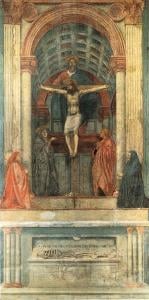
Portrait of a Young Man (1425) Masaccio
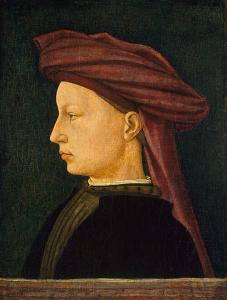
594 years ag0
May 30, 1431
19-year-old St. Joan of Arc is burned at the stake in Rouen.
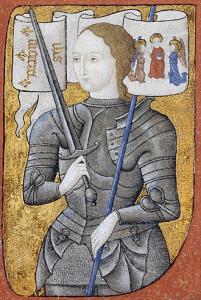
585 years ag0
1440
The Printing press is invented by Johannes Gutenberg, rapidly changing Europe.
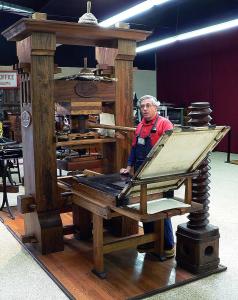
vlasta2 – Flickr: PrintMus 038
David is a bronze statue of the biblical hero by the Italian Early Renaissance sculptor Donatello, probably made in the 1440s, and now in the Bargello, Florence. Nude except for helmet and boots, it is famous as the first unsupported standing work of bronze cast during the Renaissance, and the first freestanding nude male sculpture made since antiquity. It depicts David with an enigmatic smile, posed with his foot on Goliath‘s severed head just after defeating the giant. The youth is completely naked, apart from a laurel-topped hat and boots, and holds Goliath’s sword.
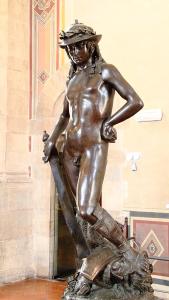
679 Years Ago
Spring –1346
A severe Bubonic Plague epidemic begins in the Crimea, marking the first major epidemic of the Black Death.
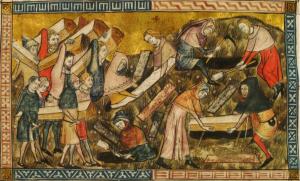
533 years ag0
October 12, 1492
Christopher Columbus with three ships makes landfall in the Americas ending the period of human habitation in the Americas now referred to as the pre-Columbian era.
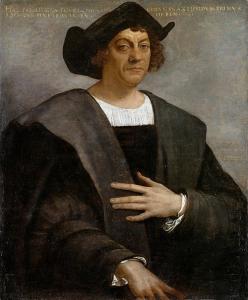
527 Years Ago
1498
1498–1499: Michelangelo carves his Pietà for St. Peter’s Basilica, Rome, in Carrara marble
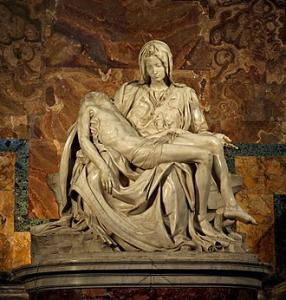
João Fernandes Lavrador and Pedro de Barcelos journey to Greenland; during their voyage, they discover the land which they name Labrador.
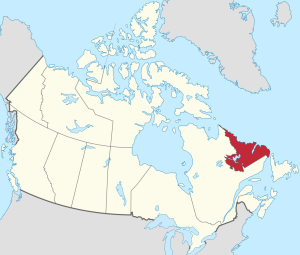
The Wiener Hofmusikkapelle, a forerunner of the Vienna Boys’ Choir, is founded by Maximilian I, Holy Roman Emperor.
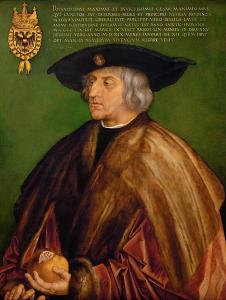
Gun barrel rifling is invented in Augsburg, Bavaria.
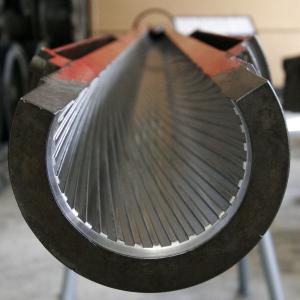
Probable date at which Leonardo da Vinci completes the painting The Last Supper, on the refectory wall of Santa Maria delle Grazie (Milan).
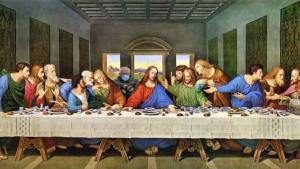
16th Century
Renascence, Reformation, Trent & Guadalupe Change 16th Cent
Europe and the New World Expand
519 years ag0
1506
Leonardo da Vinci completes most of his work on the Mona Lisa.
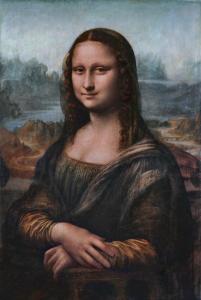
513 Years Ago
November 1, 1512
The ceiling of the Sistine Chapel, painted by Michelangelo, is exhibited to the public for the first time.
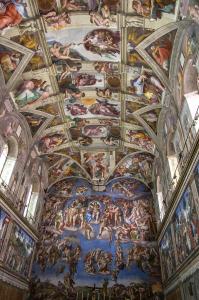
511 Years Ago
1514
The Sistine Madonna, also called the Madonna di San Sisto, is an oil painting by the Italian artist Raphael. The painting was commissioned in 1512 by Pope Julius II for the church of San Sisto, Piacenza, and probably executed c. 1513–1514. The canvas was one of the last Madonnas painted by Raphael. Giorgio Vasari called it “a truly rare and extraordinary work”
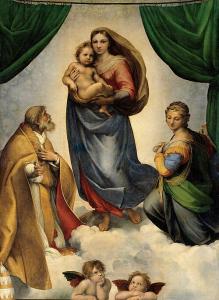
508 years ag0
October 31, 1517
Martin Luther publishes his 95 Theses (posting them on the door of the Wittenberg Castle Church) and begins the Protestant Reformation. This story is possibly apocryphal.
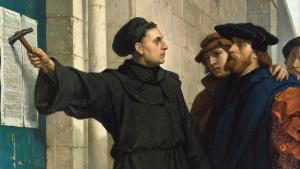
499 Years Ago
August 9, 1526
Lucas Vázquez de Ayllón of Spain founded the failed colony, San Miguel de Gualdape in present-day Winyah Bay, Georgetown County, South Carolina. It was the first European settlement, as well as the first documented occurrence of enslavement of African peoples in what would later become the continental United States.
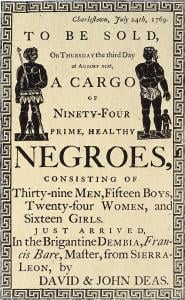
494 Years Ago
December 12, 1531
Mary, the mother of Jesus, in the guise of Our Lady of Guadalupe, appears imprinted on the tilmàtli of Juan Diego Cuauhtlatoatzin, an Aztec convert to Catholicism, in Tepeyac near Mexico City.
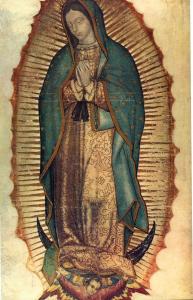
485 Years Ago
September 27, 1540
The Society of Jesus (Jesuits) is founded by Dr. St. Ignatius of Loyola and six companions including Dr. St. Francis Xavier is approved by Pope Paul III, in his bull Regimini militantis Ecclesiae.
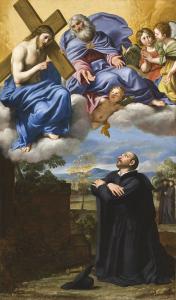
Gregorian Exploration & Reformation Expand The 16th Century
462 Years Ago
December 4, 1563
The Council of Trent (which had opened on December 13, 1545) officially closes.[17] It reaffirms all major Roman Catholic doctrines, and declares the Deuterocanonical books of the Old Testament to be canonical, along with the rest of the Bible. Chapter 1, Session 24, promulgates the decree Tametsi, stipulating that for a marriage to be valid, consent (the essence of marriage) as expressed in the vows has to be given publicly before witnesses, one of whom has to be the parish priest.
460 years ago
September 8, 1565
St. Augustine, Florida (named after Augustine of Hippo), is established by Pedro Menéndez de Avilés, becoming the oldest surviving European settlement in the modern-day United States, and a mass of Thanksgiving is said.
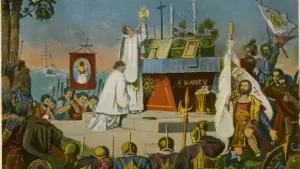
457 Years Ago
November 28, 1568
Doctors and Saints Teresa of Ávila and John of the Cross found the Discalced Carmelites.
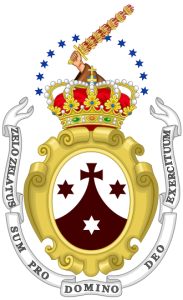
456 Years Ago
1569
The papal bull Consueverunt Romani Pontifices by the Dominican Pope Pius V officially established the devotion to the rosary in the Catholic Church. St. Peter Canisius, a Doctor of the Church, who is credited with adding to the Hail Mary the sentence “Holy Mary, Mother of God, pray for us sinners”, was an ardent advocate of the rosary and promoted it (and its Marian devotion in general) as the best way to repair the damage done to the church by the Reformation
443 Years Ago
1582
The Gregorian calendar is the calendar used in most parts of the world. It was introduced on February 24 with a papal bull, and went into effect in October 1582 by Pope Gregory XIII as a modification of, and replacement for, the Julian calendar.
17th Century
The Century Before America
420 years ago
1605
- Don Quixote by Miguel de Cervantes (September 29, 1547 (assumed) – April 22, 1616) is published. A founding work of Western literature, it is often labeled as the first modern novel and one of the greatest ever written. Don Quixote is also one of the most-translated books in the world.
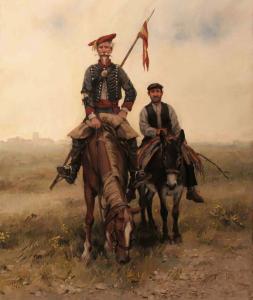
Some of William Shakespeare’s plays are given their first performance including A Midsummer Night’s Dream, Henry V, Love’s Labour’s Lost, and The Merchant of Venice.
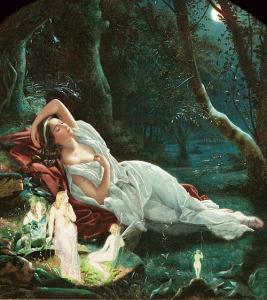
419 Years Ago
February 26, 1606
Sailing on the Dutch ship Duyfken, Dutch navigator Willem Janszoon and the crew make the first confirmed sighting of Australia by a European, reaching the Cape York Peninsula, at the Pennefather River near what is now Weipa, Queensland. The Duyfken follows by exploring the western coast.
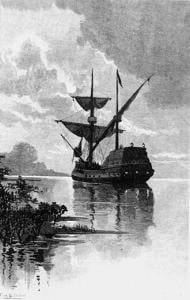
418 years ago
May 14, 1607
Jamestown, Virginia, is established as the first permanent English settlement in North America, beginning the American frontier.
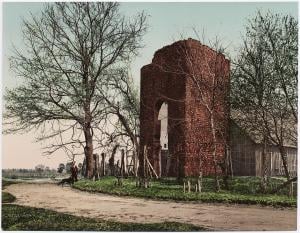
405 Years Ago
1620
- January 7 – Ben Jonson‘s play News from the New World Discovered in the Moon is given its first performance, a presentation to King James I of England. In addition to dialogue about actual observations made by telescope of the Moon, the play includes a fanciful discussion of a lunar civilization, featuring a dance by the “Volatees”, the lunar race.
- May 17 – The first merry-go-round is seen at a fair in Philippapolis, Turkey.
- June 3 – The oldest stone church in French North America, Notre-Dame-des-Anges, is begun at Quebec City in modern-day Canada.
- December 21, 1620 Plymouth Colony: William Bradford and the Mayflower Pilgrims land near what becomes known as Plymouth Rock, in Plymouth, Massachusetts.
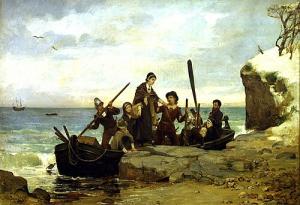
404 Years Ago
October 9, 1621
The Pilgrims of Plymouth Colony and Wampanoags celebrate a harvest feast (three days), later regarded as the First Thanksgiving, noted for the temporary peace between the English and the local Indians. The celebration is believed by later historians to have coincided with Michaelmas, observed on September 29 by the Anglican Communion on the calendar used in England at the time.
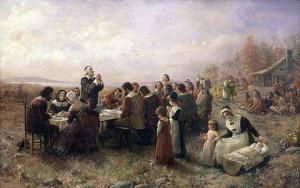
November 11, 1621 – The ship Fortune arrives at Plymouth Colony, with 35 more settlers.
402 Years Ago
Between November 8 and December 5
1623
Publication of the “First Folio” (Mr. William Shakespeares Comedies, Histories, & Tragedies), a collection of 36 of the plays of Shakespeare, half of which have not previously been printed, compiled posthumously by actors John Heminges and Henry Condell and published by Isaac Jaggard and Edward Blount in London. The first recorded purchase is on December 5, of two copies at £1 each by Sir Edward Dering.
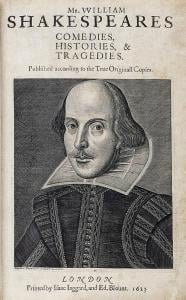
393 Years Ago
February 22, 1632
Galileo‘s Dialogue Concerning the Two Chief World Systems is published in Florence.
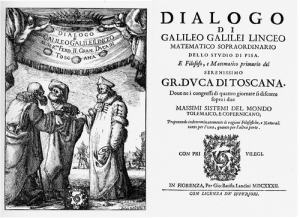
The Anatomy Lesson of Dr. Nicolaes Tulp is a oil painting on canvas by Rembrandt housed in the Mauritshuis museum in The Hague, the Netherlands. It was originally created to be displayed by the Surgeons Guild in their meeting room. The painting is regarded as one of Rembrandt’s early masterpieces.In the work, Nicolaes Tulp is pictured explaining the musculature of the arm to a group of doctors. Some of the spectators are various doctors who paid commissions to be included in the painting. The painting is signed in the top-left hand corner Rembrant. f[ecit] 1632. This may be the first instance of Rembrandt signing a painting with his forename (in its original form) as opposed to the monogram RHL (Rembrandt Harmenszoon of Leiden), and is thus a sign of his growing artistic confidence.
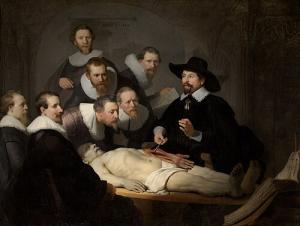
1633
The Storm on the Sea of Galilee oil-on-canvas painting by the Dutch Golden Age painter Rembrandt van Rijn. The painting vividly portrays the biblical miracle in which Jesus calmed the storm on the Sea of Galilee, as recounted in the fourth chapter of the Gospel of Mark, with additional resonance from accounts in Luke 8:22–25 and Matthew 14:22–33. Notably, it is Rembrandt’s only known seascape, distinguishing it within his oeuvre dominated by portraits, biblical scenes, and historical narratives.
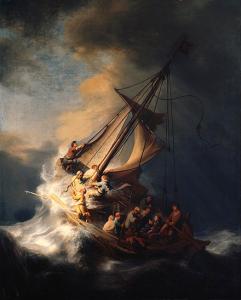
April 12, 1633 – Galileo Galilei is convicted of heresy by the Roman Catholic Church.
June 22, 1633 – The Roman Catholic Church forces Galileo Galilei to recant his heliocentric view of the Solar System. According to legend, he claims Eppur si muove.
358 Years Ago
1667
Paradise Lost by John Milton (December 9, 1608 – November 8, 1674) is published.
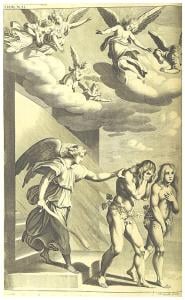
349 Years Ago
1676
Scholarly descriptions of what would now be recognized as dinosaur bones first appeared in the late 17th century in England. Part of a bone, now known to have been the femur of a Megalosaurus, was recovered from a limestone quarry at Cornwell near Chipping Norton, Oxfordshire.
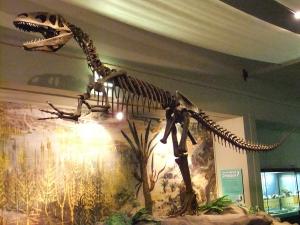
Megalsoaurus skeleton, World Museum Liverpool, England. Found in southern England.
347 Years Ago
1678
Pilgrim’s Progress by John Bunyan (November 30, 1628 – August 31, 1688) is published.
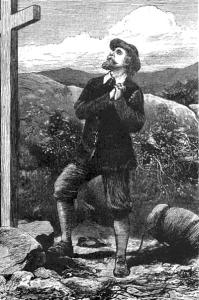
338 Years Ago
July 11,1687
Isaac Newton‘s Philosophiæ Naturalis Principia Mathematica, known as the Principia, is published by the Royal Society of London. In it, Newton describes his law of universal gravitation, explains the laws of mechanics, and gives a formula for the speed of sound. The writing of Principia Mathematica ushers in a tidal wave of changes in thought, significantly accelerating the Scientific Revolution by providing new and practical intellectual tools, and becomes the foundation of modern physics.
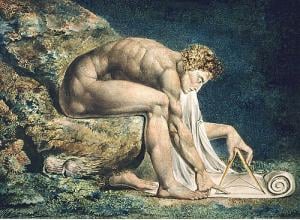
332 Years Ago
March 1, 1693
The Salem witch trials begin in Salem Village, Massachusetts Bay Colony, with the charging of 3 women with witchcraft. Tituba, a slave owned by Samuel Parris, is the first to be arrested, and she implicates Sarah Good and Sarah Osborne, who are arrested later in the day.

18th Century
316 Years Ago
1709
The first piano was built by Bartolomeo Cristofori
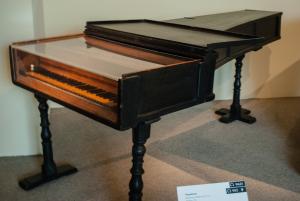
Shriram Rajagopalan – Flickr: Met-32
315 Years Ago
1710
The world’s first copyright legislation, Britain’s Statute of Anne, takes effect.
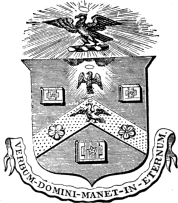
306 Years Ago
1719
Robinson Crusoe by Daniel Defoe (1660 – 24 April 1731) is published. It is often credited as marking the beginning of realistic fiction as a literary genre. It is generally seen as a contender for the first English novel. The sequel, The Farther Adventures of Robinson Crusoe is also published.
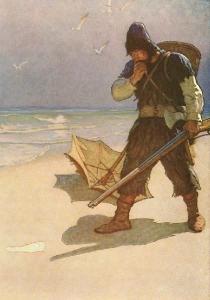
302 Years Ago
May 30, 1723
Johann Sebastian Bach assumed the office of Thomaskantor in Leipzig (now an internationally known boys’ choir founded in Leipzig in 1212) presenting his first new cantata, Die Elenden sollen essen, BWV 75, in the St. Nicholas Church on the first Sunday after Trinity.
299 Years Ago
1726
Gulliver’s Travels by Jonathan Swift (Anglo-Irish) (November 30, 1667 – October 19, 1745) is published.
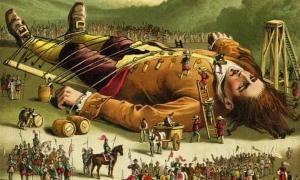
285 Years Ago
1740
- Modern steel was developed by Benjamin Huntsman.
- December 20 – Start of a revival in the London theatre of Shakespeare plays featuring actresses in travesti roles, at the Theatre Royal, Drury Lane with Hannah Pritchard as Rosalind in As You Like It, a play not performed for at least 40, and probably nearer 100, years.
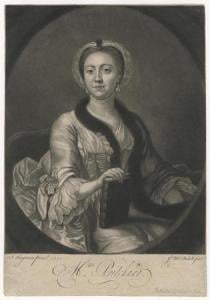
284 Years Ago
May 14, 1741
HMS Wager, one of the vessels of George Anson’s voyage around the world, is wrecked on the coast of Chile, killing most of the crew who have survived scurvy.
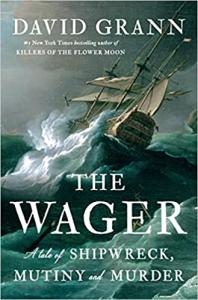
283 Years Ago
1742
Marvel’s Mill, the first water-powered cotton mill, begins operation in England.
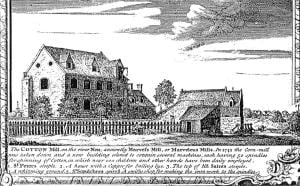
1742: Messiah, oratorio by Handel premiered in Dublin
281 Years Ago
1744
A Little Pretty Pocket-Book becomes one of the first books marketed for children.
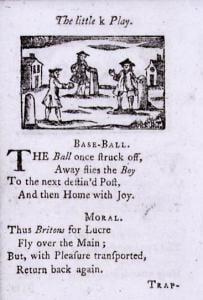
277 Years Ago
1748
Pompeii rediscovered as the result of formal excavations by Spanish military engineer Rocque Joaquin de Alcubierre.
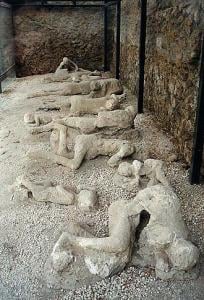
274 Years Ago
- January 3–Benning Wentworth issues the first of the New Hampshire Grants, leading to the establishment of Vermont.
- September 12 – The first recorded game of baseball is played, by Frederick, Prince of Wales, at Kingston upon Thames in England.
- December 7 – St. Father Junípero Serra begins his missionary work in the New World, 100 days after departing on a voyage from Spain and a day after his arrival at Veracruz in Mexico. During the period from 1769 to 1782, Serra will be the founder of nine missions in the Province of Las Californias, including the sites around which future California cities will be built, including Mission Basilica San Diego de Alcalá in 1769 and Mission San Francisco de Asís in 1776.
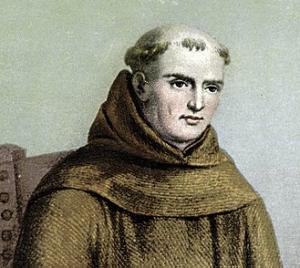
Catholic Bard’s Guide To History Timeline Of Articles
A Link List To The Catholic Bard’s History Articles.
Information was obtained through Wikipedia


